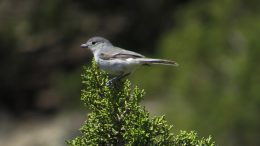Every morning, at this time of year, a red-winged blackbird greets me as I walk down the street. He’s become a familiar sight and sound, and I watch for the flash of black and red that tells me he’s landed on a branch above my head and is about to speak up.
But how many less flashy birds do I miss while looking for those blackbirds? Chances are, quite a few — just like the scientific community, according to new research published in the journal Proceedings of the Royal Society B.
The study, by a team of researchers from the University of Toledo and Ohio University, examined 55 years’ worth of scientific papers on North American birds and found they show a dramatic bias toward more noticeable species — those who are more aesthetically pleasing or “flashy,” have wider breeding ranges, and whose ranges overlap with nearby universities.
And yes, that includes red-winged blackbirds. Of the more than 27,000 published papers analyzed for this study, red-winged blackbirds were the second-most researched species, with an astonishing 499 publications. That’s second only to the bright blue-and-white tree swallow, the subject of 597 papers (perhaps because their adaptability to backyard nest boxes makes them so easy to study).
That leaves many species — the “drab” ones, as the study puts it, and the ones with smaller ranges — understudied, if studied at all. A rather plain but sweet-looking species called the Philadelphia vireo wasn’t studied a single time during this 55-year period, according to the analysis.
This bias can create a negative feedback loop, the paper warns, where the most-studied species keep getting studied and the “drab” species fade into the background, forgotten by both science and the public. The “lack of research on visually unremarkable and unfamiliar birds may ultimately result in their ‘societal extinction,’” researchers warn.
I reached out to lead author Silas Fischer, a Ph.D. candidate at the University of Toledo, to learn more about this bias, how it affects conservation, and what other researchers can do to help correct it.
The following has been edited slightly for style and brevity.
Is a possible interpretation of this paper, “In praise of boring birds?”
I suppose part of our findings could be interpreted that way, although I wouldn’t use the word “boring” to describe those species! What some of these drably plumaged species lack in color and plumage contrast, they make up for in personality.
What was the origin story for this paper? I noticed that many of your previous papers cover the gray vireo, which your new study quantifies as a “drab,” understudied bird.
I think the impetus of the paper comes from multiple observations and experiences I’ve had over the years, both as a young scientist and someone who observes birds recreationally. One part of it originated from the experiences I’ve had studying a species — the gray vireo — that most people have never heard of. Even many ornithologists and birders tend to forget about it.
A lot of my research has been on dryland birds in New Mexico, many of which have drab gray or brown plumage. They also tend to occur away from roads and people, so they’re easily overlooked — out of sight, out of mind.
I’m not implying causation here, but I’ve had papers rejected on the premise of not being interesting or novel enough — even if there is next-to-nothing known about some of these species in a Western science context. Then a few months later, the same journal publishes a paper on a similar topic but on a different, flashier species for which there is already a lot of research, conservation concerns and efforts, and sometimes even dedicated species-specific working groups.
It’s interesting to see millions of dollars spent on some species, while at the same time we lack even a basic understanding of other species’ biology. And that’s coming from someone who studies birds, which are really well studied overall compared to some other taxonomic groups.
Part of the impetus also comes from my experiences birding around others. For example, I was birding at the Magee Marsh boardwalk in Northwest Ohio, which during songbird migration is a popular birding spot. I regularly overhear other birders marveling over the flashy warblers in breeding plumage, while overlooking other comparatively less-flashy birds like vireos and sparrows. Some folks ask about whether I or a friend were “seeing anything good,” dismissing our responses if we didn’t say, for example, blackburnian warbler or golden-winged warbler.
Don’t get me wrong, I love warblers too! But I also want to observe and know other species.
Did you have any challenges conducting the study?
Mostly it was just time consuming, especially doing the manual publication filtering. That and being so excited to share our research with the world but having to wait years during the peer-review and publication process. But that’s not unique to our paper by any means.
When the results came in, were there any surprises?
We were not overly surprised that visual appeal, familiarity, and accessibility were significant predictors of the variation in publication numbers among species. But we were surprised that those three metrics combined to explain nearly half of that variation.
We were also surprised that eponymously named bird species — those whose common names refer to a human name — were studied less often than other birds in the dataset.
I think our work highlights why and how biologists can bring their human biases to all aspects of biology, which should be of concern for biologists, regardless of their study taxa, moving forward.
Could you give an example of a “flashy” species that’s potentially been overstudied or a “drab” bird that your research suggests is understudied because of this bias?
I can’t say that any one certain species was or was not studied because of these specific biases — I can’t imply causation for or against studying specific species, just that there is a trend toward focusing on visually appealing, familiar, and accessible species in our dataset — but I can tell you some of the most and least studied species. Some well-studied species were tree swallows, red-winged blackbirds, American redstarts, and white-throated sparrows. Some of the relatively understudied species were Philadelphia vireos, crissal thrashers, black-chinned sparrows, and olive warblers.
What’s the conservation cost of this bias?
Good question. One of the premises of conservation biology is that all species have value. But it’s clear that value is not equally distributed among bird species, nor among other organisms across the tree of life.
The value we attribute to species has direct implications for how much time and money we allocate to each species and can even impact a species’ designated conservation status. In conservation we rarely have all the knowledge we need to make important decisions in the face of biodiversity loss. But by selectively studying only a subset of bird species, and neglecting others, we widen the knowledge gap between them.
For the understudied birds, we often lack basic information on their ecology. And we lack fundamental data that help us understand whether a species is declining, much less what is driving those declines. Many of the conservation status designation decisions — for example, whether a species is endangered — rely on the information available. But if that information does not exist, then what? We can’t really assess a species’ threat status or implement meaningful conservation actions in those cases.
Has conducting this study and identifying this bias affected your own work in any way?
It’s hard to say at this point because this was largely a side project that I’ve been working on as I write my dissertation! But I will say I’m motivated to keep studying the dull, drab, distant birds.
How can other researchers correct this bias in their own work?
The first step is awareness. When you’re in the phase of research where you get to choose your next study topic — if it’s not already dictated by, for example, funding availability — think about whether you’re leaning towards a species because of how exciting it is visually, how familiar it might be, or how accessible it is to you.
Sure, logistics play a big part in how feasible some projects are. But I’d be willing to bet that for most folks there are a suite of species in an area that are feasible to study, and it’s important to make sure we aren’t making those decisions based on our implicit biases.
But it’s also important to point out that many funding agencies, such as state wildlife agencies, identify species of conservation concern or priority species. Then some or all of the funding available for research is earmarked for those specific species in the call for proposals. In these cases, researchers might be left with no choice but to study the priority species if they want funding, which they need to further their careers.
The bottom line is that it’s not all the fault of researchers. It’s a complex feedback cycle, which bias might influence species’ value at each link in the chain and their connections. There’s probably not one sole link in the chain that’s driving the skew in research — it’s the whole interconnected system of public attention and interest, media representation, policies, conservation practitioners’ priorities and species status designations, funding availability, etc. that feed into one another.
It’s complicated. But simple awareness, followed by conscious action, can make a difference.
Does looking at peer-reviewed science leave anything out? Citizen-science bird counts, eBird, and iNaturalist might contain more data on these “drab” species.
We didn’t analyze whether these metrics explain attention to species among citizen science efforts, so I can’t make any definitive statements about that. However, there have been some studies assessing potential bias in citizen science efforts, for example among birds and butterflies. And anecdotally, as I mentioned, I have witnessed again and again birdwatchers disregarding some birds in favor of flashier ones. I can say that there are some species whose characteristics make them less conducive to surveying through efforts like the Breeding Bird Survey.
The preprint of this paper has been out since 2023. Any response from the community to that or the new publication?
The preprint generated quite a bit of buzz on social media! I think it had nearly 60,000 views on Twitter. A lot of folks said they were not surprised about our results.
You’re also an accomplished artist. Is there any bleed-over between this science and your art?
A lot of my art I’ve made in conjunction with my scientific research. I see the two as going hand in hand — they’re both part of my research practice. I’ve been slowly building a body of work based on my research on gray vireos and some of my experiences, and this work surely bleeds into that, whether conscious on my part or not. I’m excited to see how it plays out in the future.

Previously in The Revelator:
Mice, Hedgehogs and Voles Need Conservation Champions


